| Water bodies of Burns Bog
|
||
Lakes, ponds, puddles, ditches, and ephemeral lakes |
||
|
This is a map of the water bodies in Burns Bog. Please note that the boundary of the water bodies are not fixed, and some areas not drawn as lakes and ponds can actually be flooded in the wet season. For more information, see the Hydrology of Burns Bog. |
|

|
|
The northwestern portion of the Bog is characterized by shallow water bodies as a result of peat harvesting. These lakes are very important for wildlife. Before peat harvesting, there were only very small water bodies in the Bog. Peat harvesting therefore increases the attractiveness of Burns Bog to wildlife. This is a rare example where the result of human disturbance is beneficial to wildlife. |
|
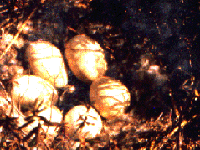
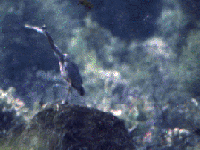
|
|
Ditches are found in many parts of Burns Bog. Many of them were installed on the eastern portion of the Bog by peat harvesters in the past. Since peat harvesting has stopped for the most part, these ditches are no longer used. However, they do continue to drain the Bog. Naturally, there are very few natural channels in the Bog. This enabled water to be retained in the Bog and created the waterlogged bog-like conditions. Now, moreover, the ditches draw water out and make some areas dangerously dry. As a result, bog vegetation communities start to retreat; they are taken over by non-bog vegetation such as birches and coniferous forest, and other communities. The ditches' adverse impact on the hydrology has been reduced by beavers. Beavers build dams along the ditches and created reservoirs for their protection and shelter against predators. The dams significantly slow down the flow of water. Recently, scientists have urged for the blocking the ditches in order to protect the long term viability of the bog ecosystem. |
|

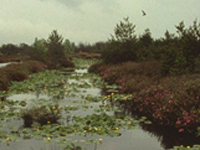

|
|
Water bodies in Burns Bog are suitable habitat not only for wildlife but for many plants. Aquatic plants are found in many lakes and canals. Sphagnum also grows in lakes. In fact, that is the process by which Burns Bog started taking over a shallow depression some 7000 years ago. As shown in this picture, Sphagnum can grow under water. After many years of slow growth, the peat moss will finally rise above the water table and reclaim the lake. This process is called "hummocking". Sphagnum usually grows in hummocks. On the larger scale, a bog is itself a giant hummock of Sphagnum, only this huge hummock is more complex and diverse. |
|
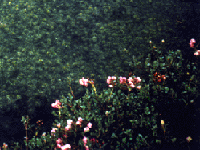
|
|
The water table is near the surface in many areas in Burns Bog. In some places, depressing the surface for a couple of centimeters is enough to make the area below the water table. This is often the case with trails in the Bog. The trail on the picture, for example, is used heavily for visitors. The visitors disrupt the surface vegetation, exposing the surface. The bare surface cannot support the weight of visitors. As a result, many spots in the trail become ephemeral puddles which are filled by water during the wet season. |
|
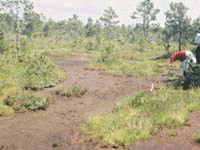
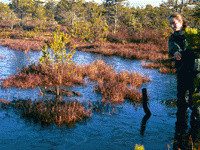
|